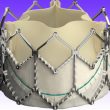1- Long-Term Foramen Ovale Closure after Cryptogenic Stroke Patent foramen ovale closure is the standard treatment for cryptogenic stroke patients. However, there are is little information on its long-term evolution. Read more 2- Descending Thoracic Aortic Aneurysms: Is There a New Plan A? The last available evidence suggests that open surgery should be the...
NOTION and UK TAVI Report Good Long-Term Outcomes
Both studies followed beyond 5 years patients with severe aortic stenosis who had undergone transcatheter aortic valve replacement (TAVR). Findings included low rates of significant valve degeneration and failure, in both cases. While data on the long-term degeneration of transcatheter-implanted valves are scarce, follow-up from the NOTION trial of low-risk patients and from the UK TAVI...
New Ultra-Thin-Strut DES: Do They Outperform Second-Generation DES?
The new drug-eluting stents (DES) equipped with ultra-thin struts are showing a lower risk of target lesion failure as a result of lower rates of acute myocardial infarction and similar rates of revascularization, according to this meta-analysis soon to be published in Circulation. Such a difference is evidenced at a 1-year follow-up when compared with...
Urgent/Emergent TAVR: A Valid Option
Courtesy of Dr. Carlos Fava. Aortic stenosis with cardiac failure or cardiogenic shock involves high mortality risk at short term. Surgery in these conditions is often unsafe, which leaves us with valvuloplasty, but only as a bridge to some other procedure, seeing as it is effective only for a short time. Few studies have looked into patients undergoing...
Diastolic Dysfunction Should Be Considered in TAVR
Aortic stenosis increases afterload creating hypertrophy as a compensation mechanism to maintain minute volume. This leads to left ventricular diastolic dysfunction (LVDD). More than half of patients presenting aortic stenosis have LVDD and myocardial fibrosis, which is a mortality predictor in surgery. At present, there is contradicting evidence in TAVR. The study looked...
Mild Leaks: TAVR’s Silent Enemies
Courtesy of Dr. Carlos Fava. Even though the presence of paravalvular regurgitation (PVR) has been reduced, thank to greater experience and new devices, it is still frequent and has an impact in survival (especially moderate and severe PVR). Recent research has shown that mild PVR also has a negative impact. However, these data were provided...
TCT 2017 | The TRI-REPAIR and the FORMA Trials: New Devices for the “Forgotten Valve”
Courtesy of SBHCI. Two new transcatheter treatments for severe or massive functional tricuspid regurgitation have showed good results at 30 days, according to their feasibility studies. The long-forgotten tricuspid valve has been gaining more attention with research linking tricuspid regurgitation to an increase in mortality. Early studies used devices originally designed for the mitral or...
Further Evidence on Managing Dysfunctioning Bioprostheses with Balloon-Expandable Prostheses
Early experience with the valve-in-valve technique in the treatment of failed bioprosthetic surgical valves in transcatheter aortic valve replacement (TAVR) has yielded acceptable acute procedural results. This turned the technique into another therapeutic option, one that could even cause the reassessment of the age limit for the surgical implantation of a mechanical or bioprosthesis valve....
TAVR in Pure Aortic Insufficiency: Yes or No?
Courtesy of Dr. Agustín Vecchia. Surgery is the treatment of choice for patients with symptomatic aortic insufficiency and/or ventricular dilatation or decreased ventricular function. The broad implementation of transcatheter aortic valve replacement (TAVR) in patients with aortic stenosis, the emergence of new devices, and the experience acquired by operators have brought this treatment to off-label indications such...
Third generation percutaneous aortic valve in intermediate-risk patients
Original title: Multicenter Evaluation of a Next-Generation Balloon-Expandable Transcatheter Aortic Valve. Reference: John Webb, et al. J Am Coll Cardiol 2014;64:2235-43 Percutaneous aortic valve replacement is starting to be a reasonable alternative in patients at intermediate risk. One hundred and fifty patients who received SAPIEN 3rd generation percutaneous aortic valve implantation were analyzed prospectively. The STS score of...









